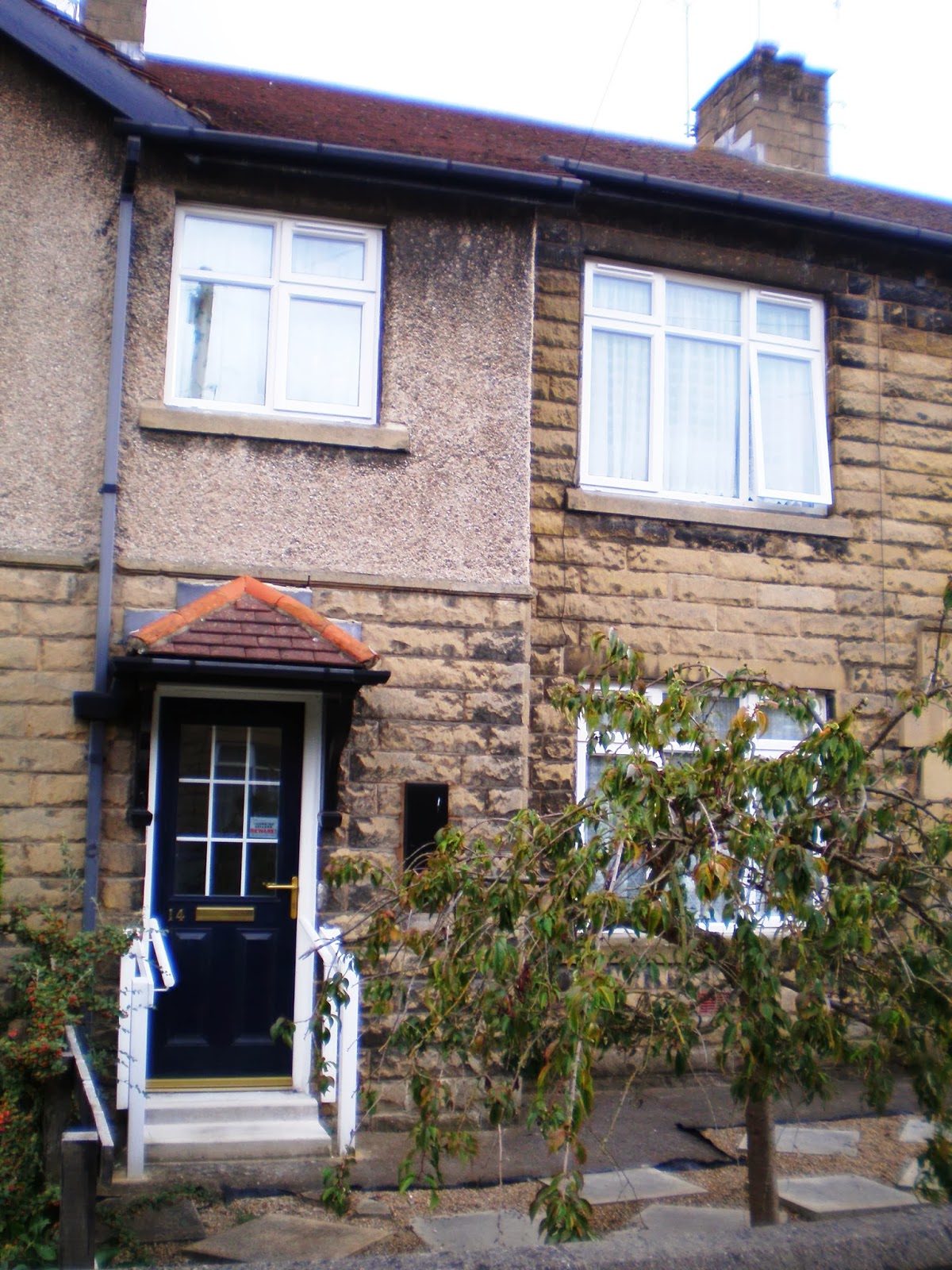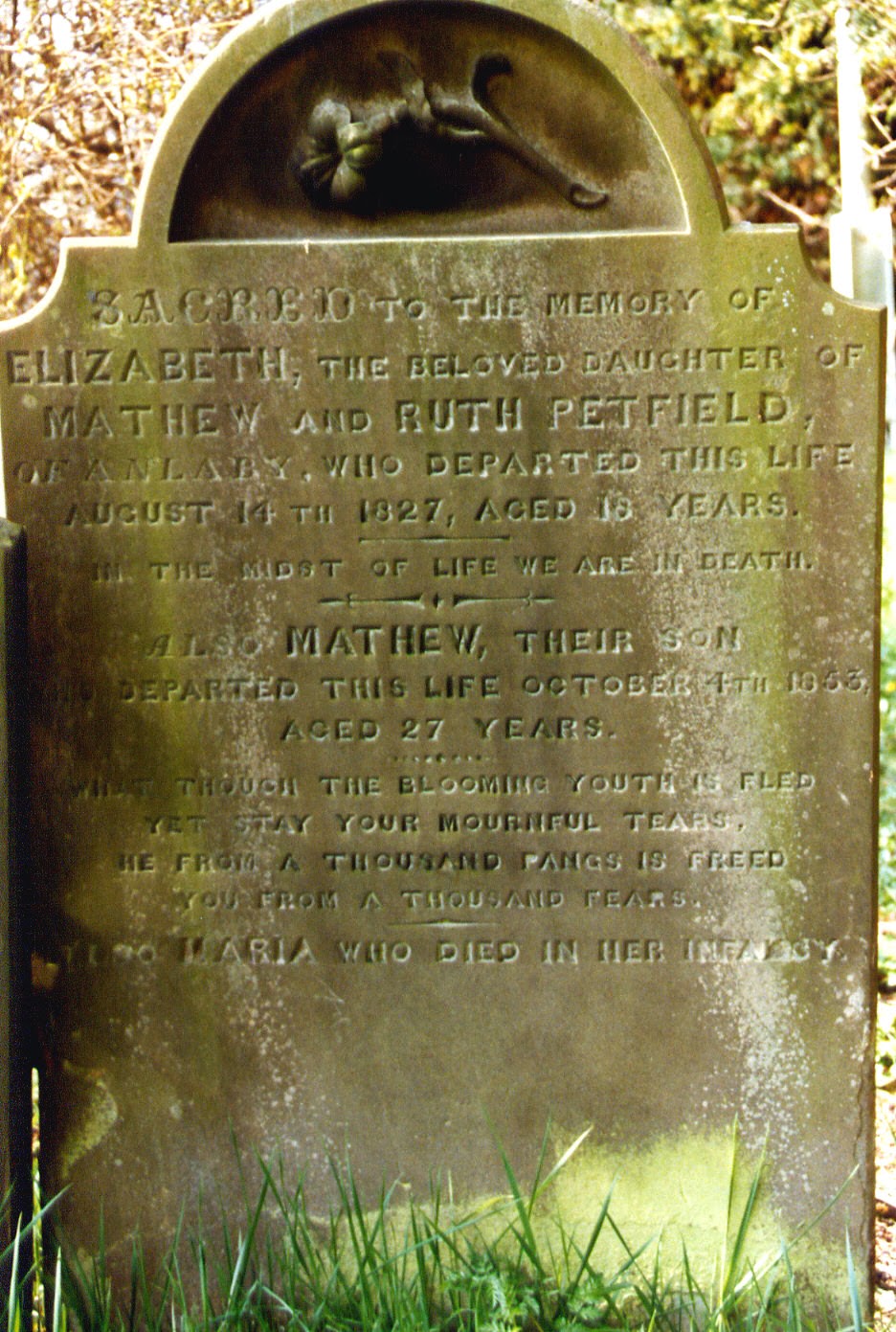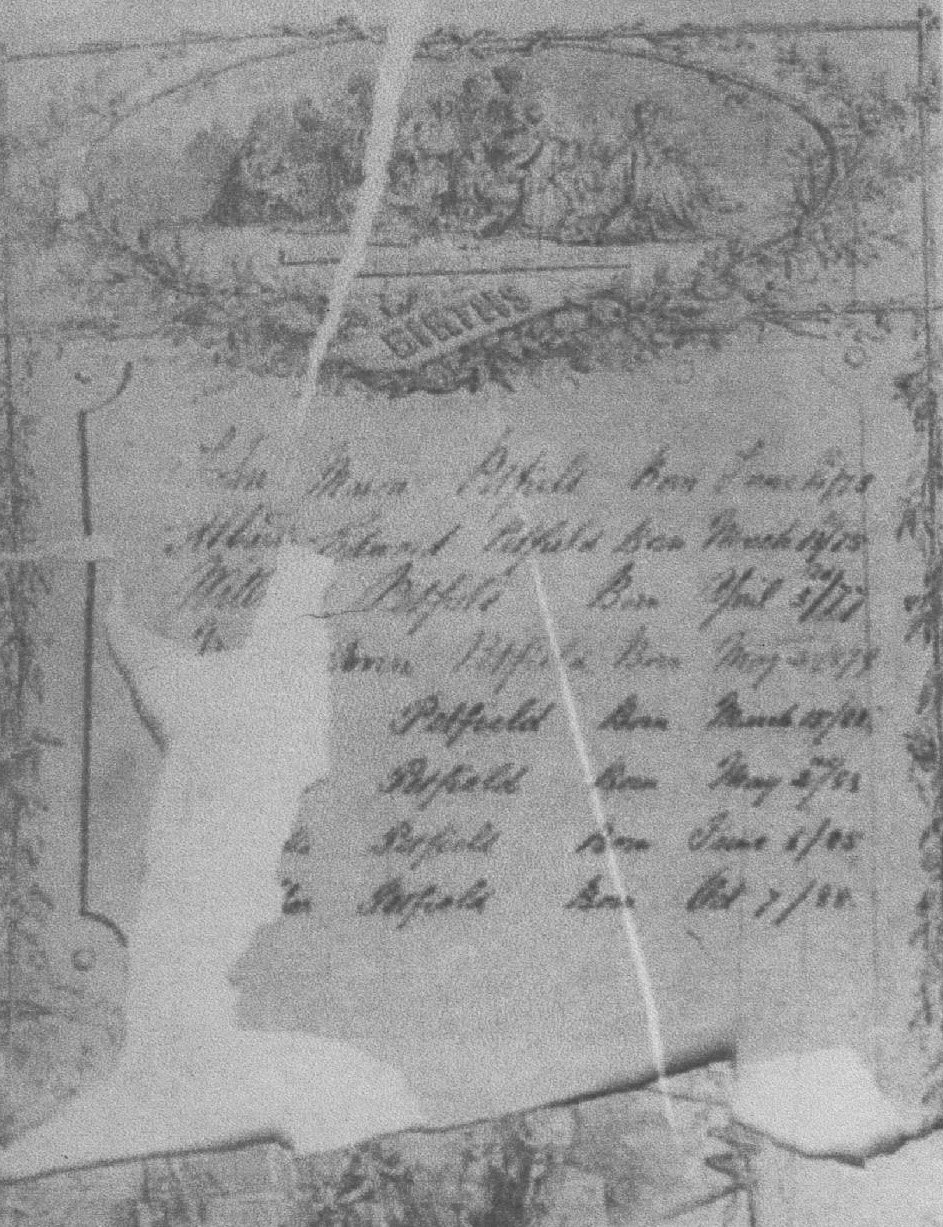https://petfieldfamilyarchives.blogspot.com
South Cave and the Petfield Family
There are early records of Petfields from 1541 in Yaxley, Essex, in Tetney, Linconshire in 1562, in Nottinghamshire in 1592, in London in 1625 and in South Cave from 1675. Many records are either lost or yet to be found.
To say that William Petfield (1735-1806) who married Mary Woolhouse (Wollas) on 21 June 1763 is the many many times Grandfather of thousands is very true. We do however have an unbroken line of Petfields from William and Mary Petfield so the emphasis of this Petfield blog is down the William Petfield & Mary Woolhouse (Wollas) line, Mathew Petfield & Ruth Jackson line, John Petfield & Mary Clark line, Edward Petfield and Mary Mason line, George Petfield and Emily Brighouse line, Allan Petfield & Winsome Macdougall line to me!
In 2020 further research discovered the following:
The father of William Petfield (1735-1806) was Matthew Petfield born 17 September 1694 in South Cave and died 1780 in South Cave. Matthew Petfield married Frances Sparrow, born 1799 in Elloughton, Yorkshire. They had 2 sons - George and William Petfield (born 1735).
The parents of Matthew Petfield (1694-1780) were George (1666-1724) and Hannah Petfield. They had 4 children - Matthew Petfield (1694-1780), Rebeckah Petfield (1700-1799), William Petfield (1705) and George Petfield (1710-1774).
The parents of George Petfield (1666-1724) were George Petfield born 1635 in Seaton Ross, Yorkshire) and Barbara Varvill born 1635 in Seaton Ross. They married in 1663 in Seaton Ross, Yorkshire.
There is also a suggestion that the parents of William Petfield (1735-1806) were George Petfield (1710-1774) & Isabel Jefferson (1707-1781) who married in 1731. George was the brother of Matthew (1694-1780).
Until further light comes to hand we will just have to wonder!
South Cave - a market village community in the 18th and 19th centuries.
The village of South Cave lies eleven miles west of the centre of Hull and eight miles south-west of Beverley in the county of Humberside. The settlement consists of two distinct district parts known as West End and Market Place. The 1801 Census gives the population of South Cave as 707 and there were 134 houses.
The farming and trading communities of Cave produced many long resident families during this period and research among the parish records and census returns has enabled the compilers of this study to reconstruct a number of genealogies of families who remained some generations in the village. The 1672 Hearth Tax returns give the first almost complete lists of heads of households and a comparison of the names given there with those in the Census Enumerators Returns 1841 -1871 reveals a dozen families that apparently remained in the village during the two centuries in question. Out of these it has been possible to trace eight with some continuity back from the mid to 19th century to the beginning of the 18th century or earlier. Those families are the Marshalls, Levetts, Gardhams, Langricks, Crosbys, Tindalls, Petfields and Waudbys.
The last two continued to be represented throughout the 19th century and into the present period, the first by the Gibson family of Joiners and the second by the generations of Waudby as Tailors and Farmers. Other trading families who established village dynasties from the early 19th century were the Donkins as Carriers, the Thornhams as Shoemakers, the Leakes as Butchers, the Goodwills as Builders and the Cousens as Plumbers and Cabinetmakers. In the book "South Cave" published in 1974 by the South Cave Branch of the Workers Educational Association, the Petfield family is listed as one of the principal family names of the village during the 18th and 19th centuries.
South Cave was an agricultural and market community and supported numerous tradesmen and craftsmen. The majority being in some way concerned with the servicing and supplying of agriculture and the processing of produce. The village usually supported three Blacksmiths, two Saddlers and a Wheelwright. One of the Blacksmiths developed in the 18th century into the iron foundry of Petfield and Farthing (William Petfield and Robert Farthing) in 1867, sited at the entrance to Beverley Road. The foundry produced ploughs and other agricultural implements which have been reported as being used as far away as the Birmingham area. It was dissolved in 1886.
The oldest reference to a market at South Cave is dated 1156, over a century before the granting of a charter in 1291 by Edward 1 "to the Master and Brethren of the Knights Templers in England, and their successors, for a market on Monday in every week at the Manor of South Kave; and one fair there every year for four days namely, on the eve, day and morrow of the Holy Trinity, and one day following". Other charters in the 14th and 15th centuries confirmed this grant. The market that survivied until the mid 19th century and the fair which lasted even later, are factors in the village history, which have been of great importance in determining its particular character.
Hull
In the words of Mathew Petfield (1836 - 1916) "All Petfields, came from Hull". True or not we may never know, we do know however that some of the family lived in the vicinity of Hull for centuries. Hull officially called Kingston upon Hull, as in 1243 Edward 1 acquired the trading settlement of Wyke at the junction of the Hull and Humber rivers. Edward 1 renamed the town Kingston Upon Hull. It was used specifically as a port for north-eastern England. The port now extends for 11 kilometers along the north bank of the Humber Estuary, which empties into the North Sea. The Humber River is about 40 miles (64 kilometers) long and large ships can navigate its waters. When the Norsemen invaded England during the 800s and 900s they sailed their boats up the river Humber. Hull is a large industrial port and the small village of Anlaby where William lived is now more like a suburb of Hull.
Religion in South Cave
In 1086, Cave was the chief manor of the hundred, or subdivision of the county, of the same name, held by Robert Malet, Baron of Eye, and had a working population of 30 villeins. On the manor were the sites of two water mills, a church and a priest. The church most probably stood in the same position as the present one, though no vestiges remain of the original church and the house of the villeins clustered around. Further settlement developed to the east of the church at the point where the road from Hull to the West Riding crossed the Roman road leading from Brough to York and Malton.
Though there is no evidence to confirm the foundation date given as 1662 on the present United Reform Church at West End. It is known that by 1672 a certain Rev.James Bayock was serving a Presbyterian meeting in the village. In 1710 the houses of John Chappelow and Mathew Eppingham were licensed as Independent meeting places and it is said that in 1715 the body had 400 members. The first chapel appears to have been erected on the present site by 1730. In 1764 the Vicar of South Cave noted that some 60 or 70 people assembled every Sunday at the meetinghouse, where a Mr.Ellis from Hull instructed them. Later in the 18th century the meeting altered from Presbyterian to Congregational and continued in a flourishing state, restoring the chapel and building a minister's residence, until a decline set in during the early years of the 19th century.
As one would expect in a market community there was much independence of thought and action, not least on religious matters and it is not surprising that during the middle decades of the 17th century, an independent congregation was established in South Cave. On Sunday 30 March 1851 a national census was taken of the members attending places of worship. The result which revealed that only half the population went to church or chapel, was a shock and humilitation to the Victorian Christians in general, and to the Anglican in particular when the high proportion of non-conformists was known. The returns for South Cave were fairly typical: Attendence on Sunday 30 March 1851.
Parish Church with 250 people, Wesleyan Chapel with 230 (70 free) people, Primitive Methodist 112 (30 free)people, Independnent West End Chapel 95 people.
Methodism was not slow in establishing itself in the village after its initial impact in the country in the 1750s, for in 1782 the house of George Turner was certified as a meeting place for the "people called Methodist". South Cave had not received a visit from John Wesley, but the villagers had an opportunity of seeing and hearing the great man when he preached at North Cave in July 1761. The former Wesleyan chapel in Church Street, now unfortunately converted into a garage, was erected in 1816 on a piece of land given by Barnard Clarkson of "Holme House", Holme on Spalding Moor, a banker and member of the country's most prestigious Methodist family. The society was not large, althrough there was a rival of interest in 1826 and the years following. There were only some 23 members in 1842.
Primitive Methodists appeared at South Cave shortly after the opening of the Wesleyan Chapel when in 1819 William Clowes, the great evangelist of the East Riding, began his preaching tours in the area. The Primitives or Ranters were followers of a group of Methodists who had been disowned by the main Wesleyan body because of their irregular meetings and "enthusiasm", a factor noticeable in the memoir of Clowes. In 1837 a chapel was built behind two cottages in Church Stereet. The Chapel and cottages were pulled down in 1876 and a commodious chapel, with school room and vestries erected on the same site at a cost of about 600 pounds.
Our family - past and present.
It seems that we descend from working class families of the 1700s. Prior to this time it is not compulsory to record marriages or births and unless the persons were famous or infamous, little will be known. Of riches and fame prior to the family coming to Australia none has been found. They were Gardeners, Builders and Blacksmiths with the odd Farmer and Fisherman. Many had large families though sickness would take many children and loved ones before their time. Education was given to few in those times and it seems that most were content to learn the skills of their parents and follow in those occupations. Many of the family especially in the later generations were community minded and their "unpaid effort" is well documented.
The family of today is one with many skills and occupations. Some of today's generation still follow the building tradition while many more have diversified into numerous professions. Many family members have attained the highest levels in their chosen careers, no doubt due to the advantage of a better education and the opportunity to choose their career.
Not only within the workplace have many changes taken place. The family today is made up of many cultures and religious beliefs. Their lifestyles vary from city to country and spare time is devoted to many activities. For the life we live now and the enjoyment of it, we must thank those who came before us, especially those who made the decision to come to this land of Australia.
Visit to England in 2007.
Joy (nee Petfield) and Peter Olney visited England in 2007, with a particular interest of going to the various villages where our ancestors had lived. Joy was not researching the family tree as such as she had already done that, but more interested in finding the Churches where ancestors were married and babies christened, or graveyards to find tombstones. We did find some homes and even went inside to meet the present owners.
As we travelled through Earl's Colne we discovered that a John Petfield (died 1562) was the Vicar at St.Andrews Anglican Church in Earl's Colne. I have not been able to find where he fits into the family tree but it was interesting to find a Petfield Vicar and worth a photo!
 |
| St.Andrew's Church in Earl's Colne where Vicar John Petfield died 1562. |
These blogs have been written by Joy Olney as another way of sharing the Petfield family history with those interested. They do not cover all branches. My interest primarily is with my direct line from William and Mary Petfield.
If you wish to contact the author of this blog with any corrections please email Joy Olney (nee Petfield) - joyolney@gmail
































+++Kirk+Ella.jpg)














.jpg)
.jpg)
.jpg)



